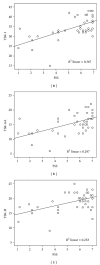Evaluation of kinesiophobia and its correlations with pain and fatigue in joint hypermobility syndrome/Ehlers-Danlos syndrome hypermobility type
- PMID: 23936820
- PMCID: PMC3725998
- DOI: 10.1155/2013/580460
Evaluation of kinesiophobia and its correlations with pain and fatigue in joint hypermobility syndrome/Ehlers-Danlos syndrome hypermobility type
Abstract
Ehlers-Danlos syndrome hypermobility type a. k. a. joint hypermobility syndrome (JHS/EDS-HT) is a hereditary musculoskeletal disorder associating generalized joint hypermobility with chronic pain. Anecdotal reports suggest a prominent role for kinesiophobia in disease manifestations, but no study has systematically addressed this point.
Objective: To investigate the impact of kinesiophobia and its relationship with pain, fatigue, and quality of life in JHS/EDS-HT.
Design: Cross-sectional study.
Subjects/patients: 42 patients (40 female and 2 male) with JHS/EDS-HT diagnosis following standardized diagnostic criteria were selected.
Methods: Disease features were analyzed by means of specific questionnaires and scales evaluating kinesiophobia, pain, fatigue, and quality of life. The relationships among variables were investigated using the Spearman bivariate analysis.
Results: Kinesiophobia resulted predominantly in the patients' sample. The values of kinesiophobia did not correlate with intensity of pain, quality of life, and (or) the single component of fatigue. A strong correlation was discovered between kinesiophobia and general severity of fatigue.
Conclusions: In JHS/EDS-HT, the onset of pain-avoiding strategies is related to the presence of pain but not to its intensity. The clear-cut correlation between kinesiophobia and severity of fatigue suggests a direct link between musculoskeletal pain and fatigue. In JHS/EDS-HT, the underlying mechanism is likely to be facilitated by primary disease characteristics, including hypotonia.
Figures
References
-
- Beighton P, de Paepe A, Steinmann B, et al. Ehlers-Danlos syndromes: revised nosology, Villefranche, 1997 Ehlers-Danlos National Foundation (USA) and Ehlers-Danlos Support Group (UK) The American Journal of Medical Genetics. 1998;77(1):31–37. - PubMed
-
- Castori M, Celletti C, Camerota F. Ehlers-Danlos syndrome hypermobility type: a possible unifying concept for various functional somatic syndromes. Rheumatology International. 2013;33(3):819–821. - PubMed
-
- Tinkle BT, Bird HA, Grahame R, Lavallee M, Levy HP, Sillence D. The lack of clinical distinction between the hypermobility type of Ehlers-Danlos syndrome and the joint hypermobility syndrome (a.k.a. hypermobility syndrome) The American Journal of Medical Genetics A. 2009;149(11):2368–2370. - PubMed
-
- Narcisi P, Richards AJ, Ferguson SD, Pope FM. A family with Ehlers-Danlos syndrome type IlI/articular hypermobility syndrome has a glycine 637 to serine substitution in type III collagen. Human Molecular Genetics. 1994;3(9):1617–1620. - PubMed
-
- Schalkwijk J, Zweers MC, Steijlen PM, et al. A recessive form of the Ehlers-Danlos syndrome caused by tenascin-X deficiency. The New England Journal of Medicine. 2001;345(16):1167–1175. - PubMed
MeSH terms
LinkOut - more resources
Full Text Sources
Other Literature Sources
Medical


